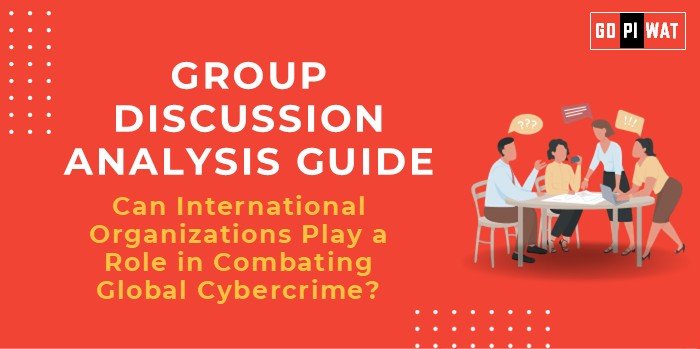📋 Group Discussion Analysis Guide: Can International Organizations Play a Role in Combating Global Cybercrime?
🌐 Introduction to the Topic
📖 Opening Context
Cybercrime has grown into a multi-trillion-dollar global threat, transcending borders and posing significant risks to governments, corporations, and individuals alike. Its scale necessitates international cooperation and collaborative mechanisms.
📜 Topic Background
The proliferation of digital technologies has simultaneously enhanced global connectivity and introduced vulnerabilities, enabling cybercrimes like ransomware attacks, financial fraud, and data breaches. International organizations such as INTERPOL, UNODC, and regional bodies are actively seeking to counter these threats by fostering cooperation, sharing intelligence, and framing global norms.
📊 Quick Facts and Key Statistics
- 💰 Global Cost of Cybercrime (2023): $8.44 trillion; projected to rise to $10.5 trillion by 2025 (Cybersecurity Ventures).
- ⚠️ Ransomware Incidents (2023): Over 600 million attacks worldwide, affecting critical sectors such as healthcare and finance.
- 🌍 International Cooperation Agreements: 87 countries ratified the Budapest Convention on Cybercrime as of 2023.
- 🔍 Interpol Cybercrime Operations: Helped dismantle 2,800 malicious online networks in 2022.
🤝 Stakeholders and Their Roles
- 🏛️ National Governments: Establish domestic cybersecurity laws and partner with international agencies.
- 🌐 International Organizations: Act as mediators for global norms, intelligence sharing, and capacity building.
- 🏢 Private Sector: Develop cybersecurity technologies and engage in public-private partnerships.
- 📢 Civil Society: Advocate for privacy rights and ethical cyber regulations.
🏆 Achievements and Challenges
✨ Achievements
- 📜 Budapest Convention (2001): First international treaty to address internet crimes through cooperation and legal frameworks.
- 🔍 INTERPOL Initiatives: Facilitated 14 major operations to disrupt global ransomware groups in 2022.
- 📊 Global Cybersecurity Index (GCI): United Nations ITU measures readiness, encouraging countries to enhance security.
⚠️ Challenges
- ⚖️ Jurisdictional Complexities: Cybercrimes often originate in jurisdictions with weak enforcement.
- 💻 Resource Gaps: Developing nations struggle with technical capacity to combat sophisticated threats.
- 🌍 Fragmentation: Lack of consensus on regulations and standards among countries.
🌍 Global Comparisons
- ✅ Estonia: A leader in cyber defense, adopting robust systems post-2007 cyberattacks.
- ⚖️ Singapore: Established a Cybersecurity Act and a dedicated Cyber Security Agency.
📖 Case Study
- 💻 NotPetya Ransomware (2017): A global attack originating from Ukraine, demonstrating the importance of international cooperation in attribution and response.
💡 Structured Arguments for Discussion
- 🛠️ Supporting Stance: “International organizations provide critical frameworks for cooperation, bridging gaps in cybersecurity capabilities across nations.”
- 🛡️ Opposing Stance: “National sovereignty and differing cyber laws impede effective global enforcement.”
- ⚖️ Balanced Perspective: “While international organizations foster cooperation, greater alignment in laws and policies is crucial for effective results.”
🎯 Effective Discussion Approaches
🔑 Opening Approaches
- 📊 Statistics-Based: “Cybercrime cost the global economy $8.44 trillion in 2023; can nations afford to address this threat alone?”
- 🔍 Success Stories: “INTERPOL’s 2022 operations against ransomware groups highlight the power of international collaboration.”
⚙️ Counter-Argument Handling
- 🔄 Example: “While national sovereignty concerns exist, the cross-border nature of cybercrime necessitates mutual cooperation.”
🧠 Strategic Analysis of Strengths and Weaknesses
SWOT Analysis:
- 💪 Strengths: Facilitates cross-border cooperation; brings resources to underdeveloped nations; creates standardized protocols.
- 🛠️ Weaknesses: Limited enforcement capabilities; variance in member nations’ commitments.
- 🌟 Opportunities: Growing need for cyber defense partnerships; adoption of AI-driven threat detection tools.
- ⚠️ Threats: Escalating sophistication of cyberattacks; lack of consensus among major powers.
🏫 Connecting with B-School Applications
📚 Real-World Applications
- 🌍 Exploring cyber risk management in international finance.
- 📊 Developing case studies on public-private partnerships.
🎓 Sample Interview Questions
- ❓ “How do international laws impact the fight against cybercrime?”
- ❓ “Can AI enhance global cybersecurity efforts?”
💡 Insights for B-School Students
- 📈 Analyze cybersecurity as a growing industry with strategic implications.
- 🤝 Explore intersections of law, technology, and business in combating cyber threats.


